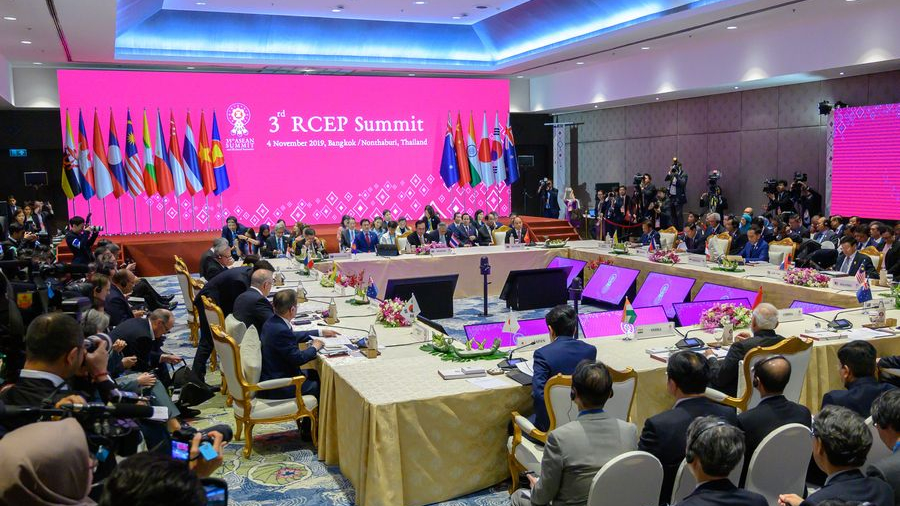
Participants attend the 3rd Regional Comprehensive Economic Partnership (RCEP) Summit in Bangkok, Thailand, November 4, 2019. /Xinhua Photo
Participants attend the 3rd Regional Comprehensive Economic Partnership (RCEP) Summit in Bangkok, Thailand, November 4, 2019. /Xinhua Photo
Editor's note: Dr. Ji Xianbai is a research fellow with the International Political Economy Program of S. Rajaratnam School of International Studies, Nanyang Technological University, Singapore. The article reflects the author's opinions, and not necessarily the views of CGTN.
At last, after six years of negotiations, a Regional Comprehensive Economic Partnership (RCEP) text was agreed to at the third RCEP Summit held in Bangkok on November 4. Once textual "scrubbing" by lawyers and linguists is completed, RCEP will be ready for signing, possibly in February 2020 and then ratification and implementation.
Admittedly, this achievement came with a price: the pull-out of India. By covering 15 fast-growing economies in East Asia which represent over 30 percent of global GDP and population, a RCEP15 without India is still the world's largest free trade area.
Then, why did India give such a tremendous trade pact a pass in Bangkok? A cursory look at India's relationship with RCEP is revealing.
India initially took part in RCEP with an eye to crafting a deal that would advance its core offensive interests in the realm of services. It later became clear to India that RCEP was meant to be a goods-heavy and services-light agreement, akin to the pre-existing ASEAN+1 trade deals that RCEP sought to harmonize. Despite such realization, India stayed on with RCEP under the government's "Act East Policy" doctrine.
But as negotiations proceeded, India's circumstances changed for the worse, drastically shaking its faith in RCEP. India consistently failed to secure meaningful concessions on services trade; its economy slowed down; it runs a widening trade deficit with 11 of 15 RCEP members, and the ruling party fared unsatisfactorily in Maharashtra and Haryana local elections.
Hence, prior to Bangkok meetings, India made several emergency demands pertaining to market access and a safeguard mechanism, trying to secure a special status for itself. However, India's requests geared toward placating domestic concerns were not accommodated. As last-minute negotiations broke down, Prime Minister Modi announced that RCEP, as it stands, is not acceptable to India.
Will India's absence cut into the economic appeal of RCEP? The answer obviously is yes – but perhaps not to the extent some have feared. My preliminary economic analyses, using the computable general equilibrium technique and assuming complete tariff removal, suggest that RCEP15 would generate a real GDP increase of approximately 137 billion U.S. dollars in the longer run. This means the bloc would retain 80 percent of the gains had India were still a member (171 billion U.S. dollars).

Chinese Premier Li Keqiang attends the 3rd Regional Comprehensive Economic Partnership (RCEP) Summit in Bangkok, Thailand, November 4, 2019. /Xinhua Photo
Chinese Premier Li Keqiang attends the 3rd Regional Comprehensive Economic Partnership (RCEP) Summit in Bangkok, Thailand, November 4, 2019. /Xinhua Photo
In fact, the simulation results demonstrate that Cambodia, Brunei, Myanmar and New Zealand – RCEP countries that have an export profile similar to India's – could be slightly better off in the absence of India. That said, RCEP without India promises marginally lower gains for all the other seven RCEP members due to a loss of huge export market.
Beyond the economic implications, concluding RCEP is a testimony to Asia's collective leadership on regional economic matters. By signaling Asia's commitment to rules-based trade openness, the formation of RCEP gives a timely boost to multilateralism. Just when the U.S. erects national security tariffs and wages an acrimonious trade war with China, Asia is driving forward deep integration on the back of RCEP – alongside the Comprehensive and Progressive Agreement for Trans-Pacific Partnership (CPTPP) which took effect in end 2018.
The relationship between RCEP and Trans-Pacific Partnership (TPP), the CPTPP's predecessor, had been characterized by geopolitical competition. TPP was conceived by Washington to contain China and RCEP was proposed as a China-led countermove to shut the U.S. out of Asian regionalism. With the U.S. gone, Asian countries have come to see the two agreements as complementary in nature.
The CPTPP gives Asian signatories exposure to high-standard trade rules while RCEP offers an opportunity for countries to get the ball of trade liberalization rolling. Since seven countries (Japan, Australia, New Zealand, Brunei, Malaysia, Singapore and Vietnam) participate in both the CPTPP and RCEP, there is a strong basis for a gradual convergence between CPTPP and RCEP insofar as political will is present.
Of course, Asia's economic clout and leadership credential will be greatly reinforced if New Delhi changes its mind on RCEP. There is still time for India to reflect on the decision taken in Bangkok. For sure, there will be short-term pains for India to grapple with, but wouldn't it better to be part of the world's largest trading bloc and have a say over emerging trade rules that will govern commercial exchanges in the world's most dynamic region?
(If you want to contribute and have specific expertise, please contact us at opinions@cgtn.com.)